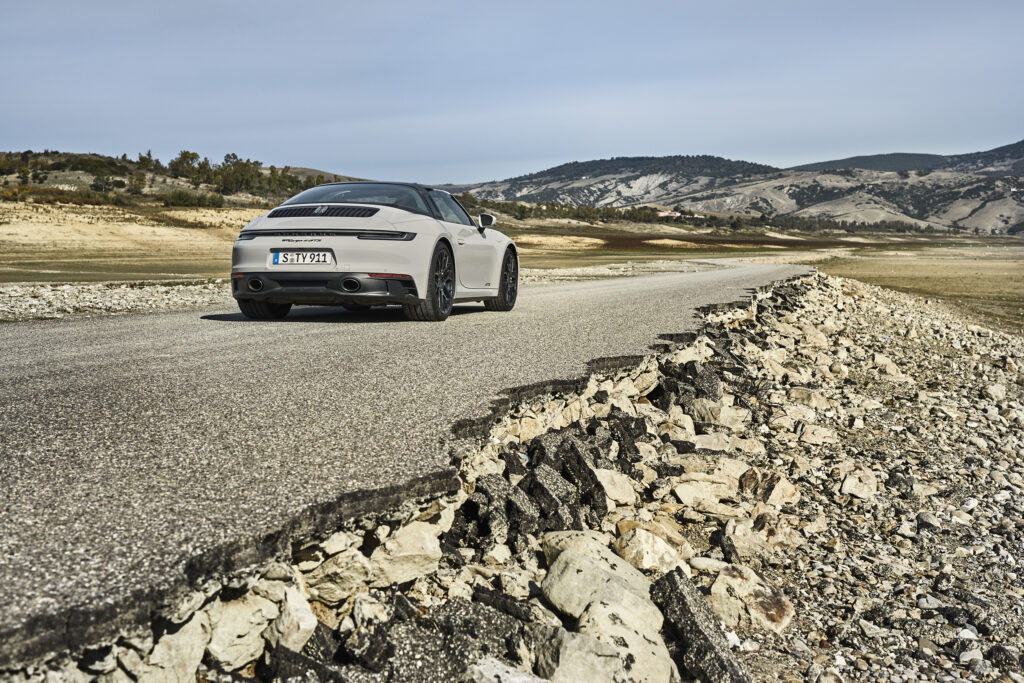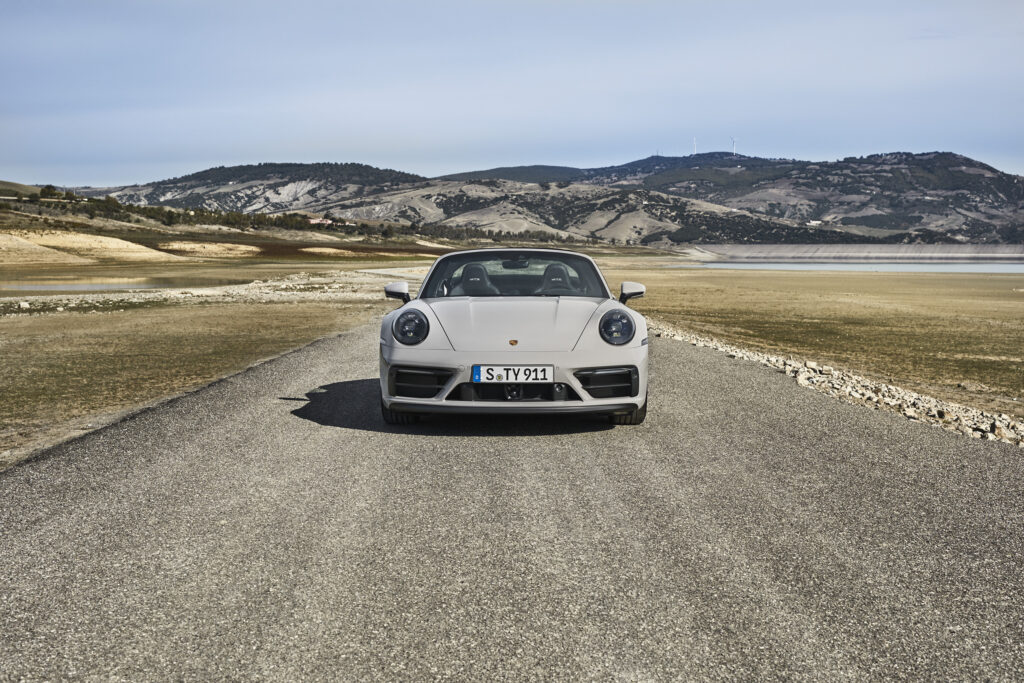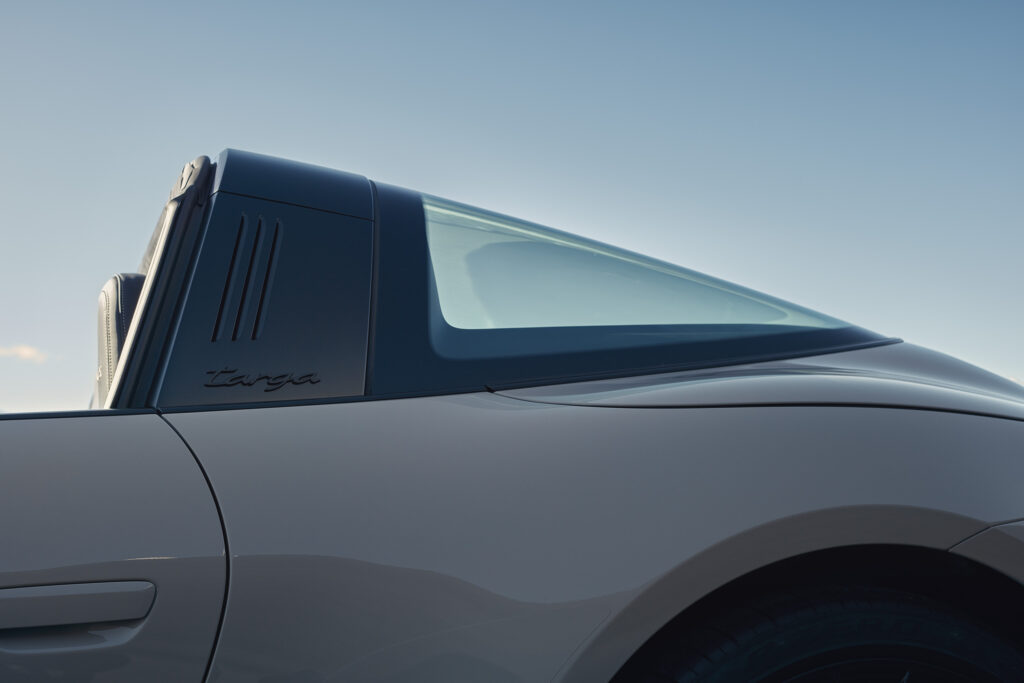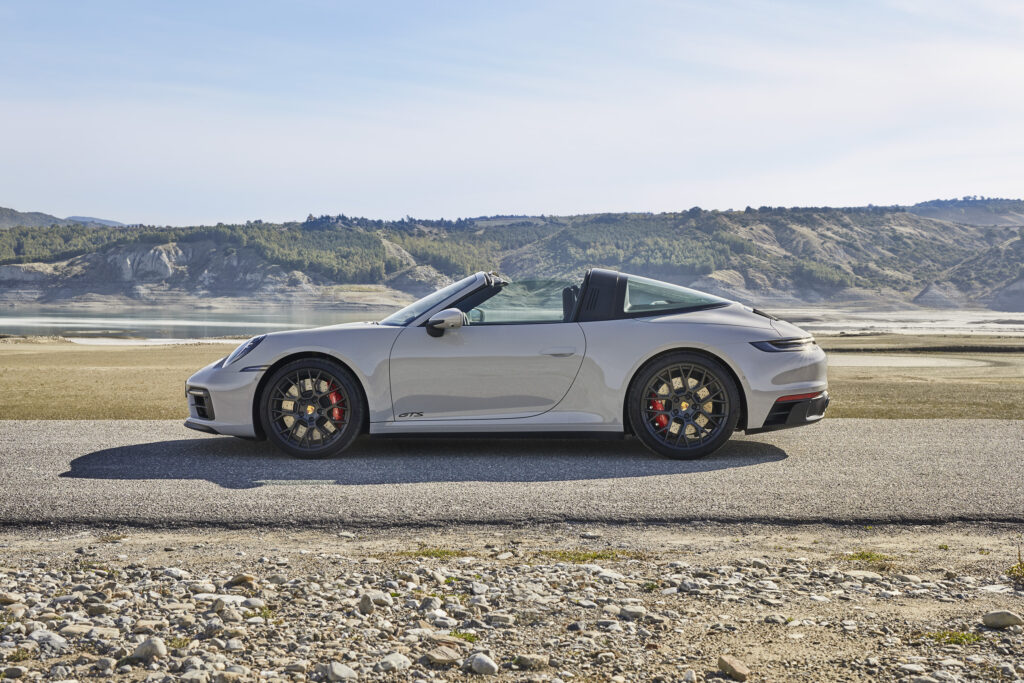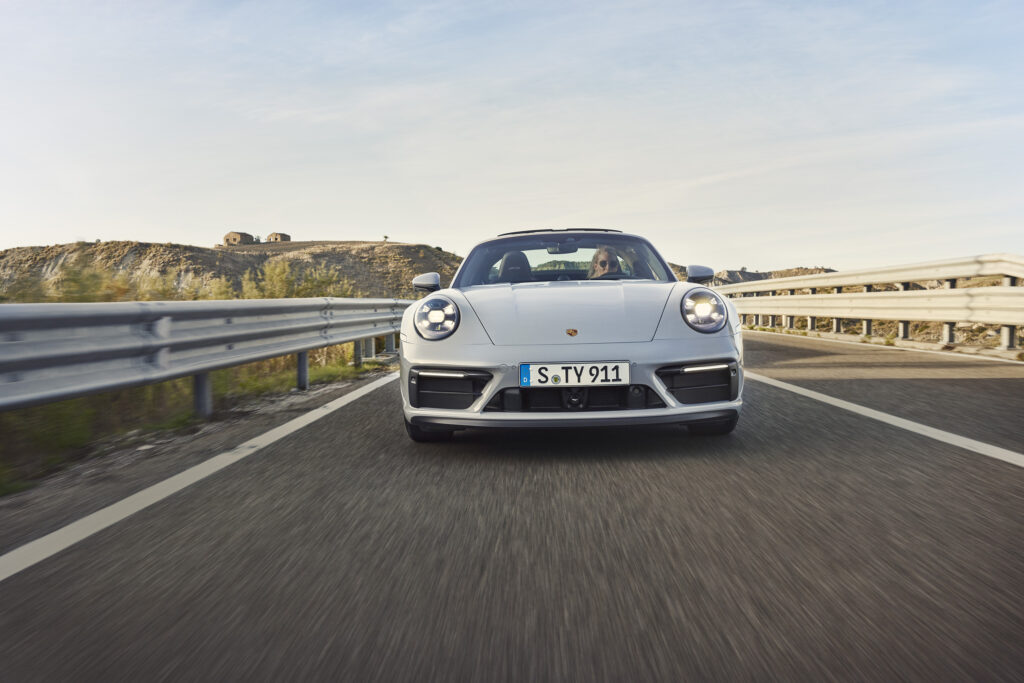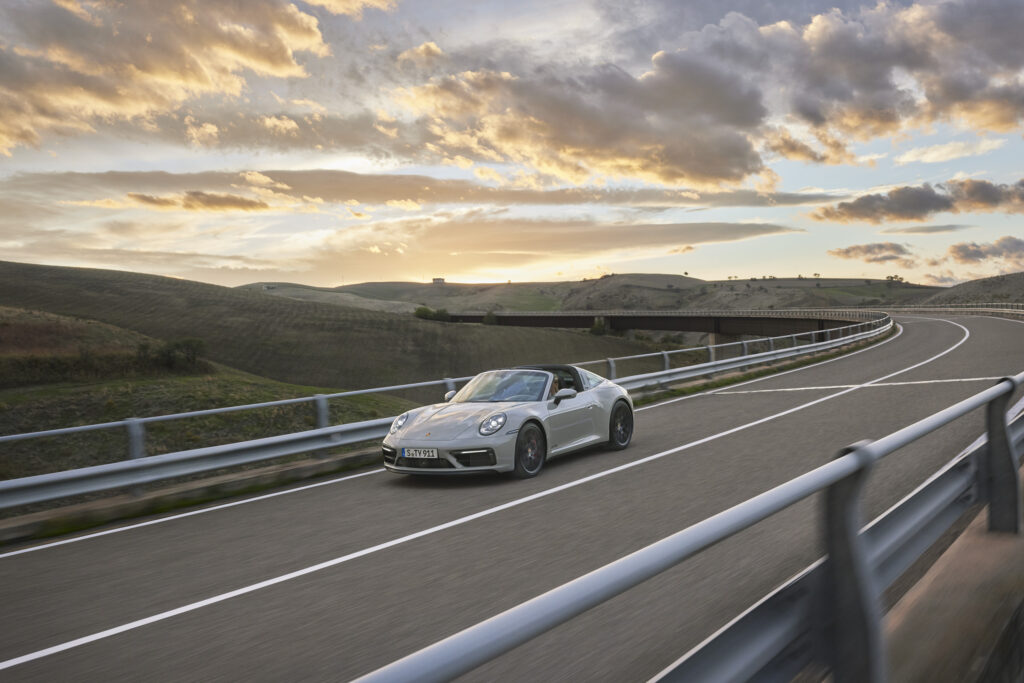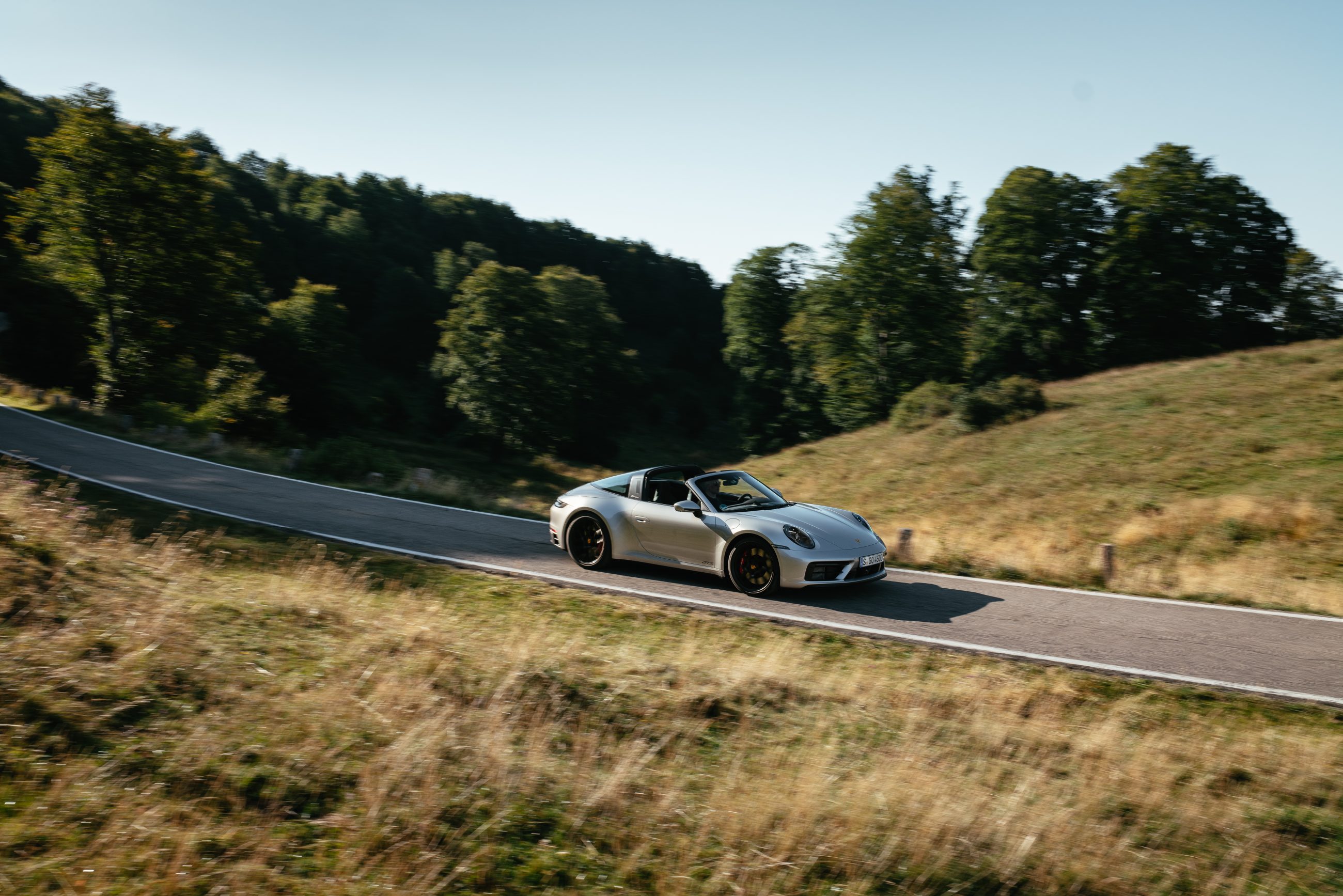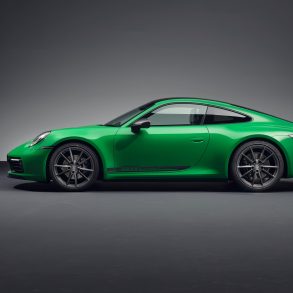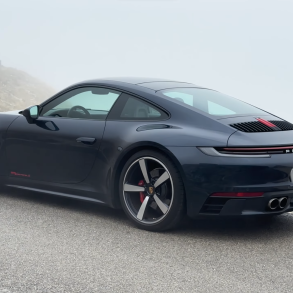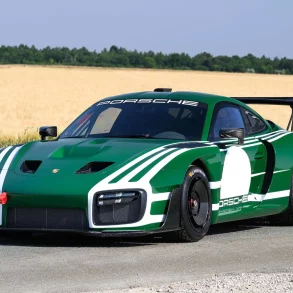2022 – 2024 Porsche 911 Targa 4 GTS (992.1) – Reviews, Pricing, Specs & Buyers Guide
The 992.1 Porsche 911 Targa 4 GTS is the extrovert of the GTS family: the same curated performance recipe that makes the GTS badge the “sweet spot,” finished with the most theatrical roof in the range and standard all-wheel drive. Under the glass-and-hoop silhouette sits the familiar 3.0-liter twin-turbo flat-six tuned to 473 hp and 420 lb-ft, a chassis lowered 10 mm with PASM Sport, Turbo-grade brakes, a GTS-specific sport exhaust (with reduced insulation for more voice), and the option of 7-speed manual or 8-speed PDK. It’s equal parts style and substance—and this guide covers its story, hardware, performance, updates, reviews, options, buying tips, and verdict.
Porsche launched the 992-series GTS line on June 23, 2021, with U.S. sales beginning for MY2022. The brief was familiar: more power than a Carrera S (473 hp / 420 lb-ft, +30/+30), and a purposeful bundle of chassis, brake, and exhaust upgrades that matter on real roads. Five variants debuted, including the Targa 4 GTS, which combines the GTS recipe with the Targa’s signature roof and standard AWD. Porsche’s own launch notes underline the power/torque increase and the quicker official acceleration times versus prior GTS models.
Where the Coupé and Cabriolet GTS use PASM Sport (–10 mm) and helper springs borrowed from the Turbo for a tauter feel, the Targa 4 GTS applies the same powertrain and much of the same character but overlays it with the Targa body’s special sauce: a panoramic glass rear section, an aluminum Targa bar, and a complex powered roof that steals the show at every coffee stop.
The Targa Thing: Roof, Structure, Drama
Compared with the Cabriolet’s simple cloth top, the Targa’s mechanism is a kinetic sculpture. The entire rear glass assembly tilts up and back, the cloth panel folds, and everything closes again with balletic precision. The full cycle takes about 19 seconds, and it can be operated while stationary (most owners also cycle it at low speeds when safe). That figure appears consistently in Porsche materials and media demonstrations. Beyond the spectacle, the system keeps the Targa quieter and more coupe-like roof-up than a conventional soft top.
Powertrain, Driveline & Chassis
Engine & Transmission
- 3.0-liter twin-turbo flat-six (VTG): 473 hp / 420 lb-ft (U.S.)—achieved mainly via increased boost over the Carrera S.
- Gearboxes: 8-speed PDK dual-clutch or 7-speed manual (shorter throw). Porsche’s technical and road-test material confirms the GTS’s 30-hp/30-lb-ft bump and the effect of higher boost pressure.
All-Wheel Drive (Targa 4)
-
Electronically controlled, water-cooled multi-plate clutch engages the front axle rapidly to maximize traction at launch and in poor conditions. It’s central to the Targa 4 GTS’s repeatable pace on real roads.
Suspension, Brakes, Wheels
- PASM Sport calibration (–10 mm) and helper springs on the rear axle (a Turbo-derived detail for consistent rebound behavior).
- Turbo-grade brakes are standard; PCCB ceramic rotors optional.
- 20/21-inch staggered wheels (center-lock design offered on many builds; five-lug also available depending on market). Publications repeatedly note these GTS hallmarks.
Infotainment & Assistance
-
The 992 platform’s PCM 6.0 infotainment received a January 24, 2022 update that refreshed the UI and added Android Auto (CarPlay already present). If seamless phone integration matters, ensure the car has this software level.
Performance: Claims vs. Reality
Porsche’s brochures are famously conservative. Independent testing of the Targa 4 GTS shows it’s properly quick despite the extra mass of the Targa mechanism:
- Car and Driver instrumented a 2022 Targa 4 GTS (PDK) at 0–60 mph in 2.9 seconds, just a tenth behind their rear-drive GTS Coupé run earlier that year. Their write-up also calls out the Targa’s slightly softer suspension tune versus Coupé/Cab GTS, trading a bit of edge for ride comfort—an intentional character choice for the Targa.
- MotorTrend’s Quick Drive concluded that the Targa 4 GTS feels “tightened up” versus a 4S—firmer, louder, faster—distilling the GTS idea into a daily-service open-top car. While not an instrumented test, their drive impression aligns with the numbers above.
The takeaway: the Targa 4 GTS gives up only tenths to a hardtop on a stopwatch while delivering a roof-down experience that’s unique to the Targa body.
How It Drives
Bandwidth defines modern GTS models, and the Targa is no exception. The higher-boost flat-six punches hard from mid-rpm; PDK executes surgical downshifts and repeatable launches; AWD makes fast progress strangely effortless in cold or damp weather. Compared to a GTS Coupé on PASM Sport, the Targa’s slightly more compliant tuning and added mass mean a shade less body discipline on really bumpy roads, but it reads as confidence-building and unflappable, not floaty. Reviewers praised its road-trip refinement roof-up and its drama + soundtrack roof-down—helped by the GTS’s sport exhaust and reduced cabin insulation.
Steering feel is classic 992: accurate and calm at speed, with rear-axle steering (if optioned) adding agility in hairpins and stability in high-speed sweepers. Some outlets note that the Targa’s weight distribution and all-wheel-drive traction prioritize tenacity on corner exit over ultimate throttle-steer adjustability—a trade most real-world drivers happily accept.
Detailed Specifications (Highlights)
- Engine: 3.0-liter twin-turbo flat-six (VTG) — 473 hp / 420 lb-ft
- Transmissions: 8-spd PDK or 7-spd manual
- Driveline: AWD (Carrera 4) with water-cooled, electronically controlled front clutch
- Chassis: PASM Sport (–10 mm) with helper springs (GTS-specific tuning)
- Brakes: Turbo-grade iron rotors; PCCB optional
- Wheels/Tires: 20 in (F) / 21 in (R); center-lock design available
- Roof: powered Targa mechanism; ≈19 s full cycle (stationary)
- Performance (tested): 0–60 mph as quick as 2.9 s (PDK) depending on conditions/spec; top-speed and 0–100 km/h claims align with GTS family norms and Porsche’s conservative figures.
Model-Year Updates
- 2022 (launch year) — Targa 4 GTS joins the 992 family with the full 473 hp/420 lb-ft tune, PASM Sport (–10 mm), Turbo-derived brakes, Sport Chrono, GTS exhaust and visuals, with PDK or 7-MT. Porsche rolls out a PCM 6.0 infotainment update on Jan 24, 2022 adding Android Auto and UI improvements to compatible cars.
- 2023 — Running refinements and option reshuffles; the Targa 4 GTS continues unchanged at its core. Contemporary reviews emphasize its unique balance of style, pace, and civility.
- 2024 — Final 992.1 year ahead of the 992.2 refresh for MY2025, when Carrera GTS moves to T-Hybrid power (context only). That effectively makes 2022–2024 the last pure-ICE Targa 4 GTS run, a detail some buyers value.
Reception & Reviews (What the Press Said)
- Car and Driver (By the Numbers, Nov 2022): 2.9-sec 0–60 for a PDK Targa 4 GTS and a note that Targa tuning is more forgiving than Coupé/Cabriolet GTS, trading a hair of edge for daily comfort. Verdict: still blisteringly quick and arguably the most “artful compromise” of the family.
- MotorTrend (Quick Drive, Mar 2023): Called the Targa 4 GTS “one of the best concoctions of 911 out there”—tightened up in all the right ways and a wonderful daily-service open-top sports car.
- Top Gear (GTS family first drives): Praised the gruffer, more urgent GTS character over a standard Carrera, with AWD enhancing tenacity on exit; minor critique of steering heft vs. chassis aggression. Useful context for the Targa 4 GTS’s attitude.
Consensus: the Targa 4 GTS nails the style–speed–usability triangle. It’s nearly as fast as the hardtop, better than the Cabriolet for roof-up refinement, and more dramatic than either when the mechanism does its 19-second ballet.
Options & Packages That Matter (Targa Focus)
- Rear-Axle Steering (RAS): High-impact option—shrinks the car in tight corners and adds calm at autobahn speeds; a great match for the Targa’s grand-touring remit.
- PCCB (carbon-ceramic brakes): Outstanding fade resistance and pedal consistency; durable in street use but costly if damaged—inspect carefully when buying used.
- Seats: Sport Seats Plus are the default sweet spot; full buckets (where available) add theater but test for long-distance comfort.
- Center-lock vs five-lug wheels: Center-locks look the business (and echo Turbo S aesthetics); five-lug wheels ease tire-swap logistics with negligible real-world performance penalty.
- Front-axle lift & driver assists: Lift saves the nose in cities; adaptive cruise and blind-spot monitoring add daily polish without diluting the experience.
(Note: The Lightweight Package with bucket seats, light glass/battery, rear-seat delete and bundled RAS was introduced for GTS Coupés; the Targa did not get the full LW pack, though individual components/specs vary by market and model year.)
Buying Guide (UsedS)
- Roof system health. Cycle the top multiple times; the 19-second routine should be smooth, quiet, and latch flush. Inspect seals after a wash and ensure the rear glass panel aligns perfectly when closed. The mechanism is robust—but complex—so perfect operation is table stakes.
- Chassis & alignment. Check inner shoulders on the 21-inch rear tires for accelerated wear; ask for a recent alignment. Cars with RAS are particularly sensitive to setup and feel terrific when dialed in.
- Brakes. Standard iron rotors are stout; on PCCB, inspect faces for chips and confirm zero pedal pulsation.
- Infotainment. If Android Auto matters, verify the Jan 24, 2022 PCM 6.0 update on early 2022 cars (CarPlay is standard).
- Spec verification. Don’t assume center-locks, RAS, or buckets are present—pull the build sheet. The Targa didn’t get the Coupé-only Lightweight Package, but many desirable options were available à la carte.
- Provenance & warranty. The 992 is robust when maintained. Prioritize clean service history, matched Porsche-approved tires, and an unmodified ECU if warranty is in play.
Ownership Experience & Verdict
Roof up, the Targa reads like a refined grand tourer—quiet, solid, and long-legged. Roof down, the GTS exhaust and slightly reduced insulation bring the flat-six to the foreground without tiring drone. PDK delivers effortless pace in traffic and on mountain passes; the 7-MT adds engagement with surprisingly little real-world penalty once rolling. And thanks to AWD, the Targa 4 GTS is the rare open-top car that feels just as capable in shoulder seasons—you don’t need perfect weather to enjoy it. Reviewers consistently frame it as the artful compromise: the GTS’s urgency, the Targa’s drama, and true everyday civility.
For MY2025, Porsche refreshed the 911 and moved the Carrera GTS to T-Hybrid power, dropping factory and tested times even further. That evolutionary step also cements 2022–2024 as the last pure-ICE Targa 4 GTS era—useful context for enthusiasts who value mechanical simplicity and the specific sound/feel of the non-hybrid 3.0TT.
If you want a 911 that feels special at any speed, that you can enjoy more days of the year, and that still thinks like a driver’s car, the Targa 4 GTS is bull’s-eye. Spec rear-axle steering for mountain roads or city agility; add PCCB if you hammer fast descents; consider center-locks if you love the look (or five-lug wheels for convenience). Make sure the roof operates perfectly and PCM is current. Do that, and you’ll own the 911 that turns every fuel stop into a small car show—and every on-ramp into a reminder that Porsche’s “compromise” is most brands’ best-case scenario.
What We Said At Launch
The 2022 Porsche Targa 4 GTS adds more grunt, packs less weight, has sharper handling, and packages it up in the sexiest bodystyle that Porsche sells. The Targa 4 GTS gives us the best of all worlds, providing all-wheel-drive traction, an open-top experience, and a fixed-roof feeling in the same car. Its automatic transmission and adaptive suspension completed the image of a daily-driver sports car. This may be the perfect car.
This bump in performance helps the Targa 4 GTS also to do 0-60 mph in under 3.3 seconds, thanks to a slick 8-Speed Porsche Dual Clutch Transmission and launch control. Top speed is a healthy 190 mph. An optional 7-Speed manual helps bump up the driving appeal and comes with a shortened gear lever for a more sporty driving experience, but it does lower the performance numbers. We know numbers aren’t everything though, which is why would always opt for the manual.
Like the rest of the GTS range, the Targa 4 GTS gets the high-performance braking system from the 911 Turbo as well as an awesome sounding sport exhaust system. Porsche Active Suspension Management (PASM) is standard and helps adapt actively to changing terrains and movements for a more dynamic driving experience. It comes standard with a Sport suspension that lowers the ride height by 10 mm (0.3 inches). The rear springs have been tuned for a widespread appeal which translates to a consistent driving experience in all driving conditions. For an even wilder driving finesse, Porsche offers a Lightweight package that saves up to 55 pounds. Other performance features include rear-axle steering and added aerodynamic underbody paneling.
Design-wise, we can see the usual Porsche 911 GTS treatment. Like the 911 Carrera GTS the exterior has experienced some subtle changes, to make it slightly more distinctive and aggressive than the less-powerful 911 Targa versions. The front fascia, in particular, has a slightly sportier look, with more distinctive individual vents. On the side, the Targa GTS looks identical to the others, except for the new sportier wheels with a center lock. At the back, we see a familiar sight from the lesser 911 models. The only notable differences are the clear taillights and the number plate location, which now belongs on the rear bumper, instead of the diffuser.
The Targa 4 GTS comes standard with the SportDesign package that adds unique trimming for the front, rear, and side sills. Even the headlamp housing is blacked-out and comes with standard LED lights with Porsche Dynamic Light System Plus (PDLS Plus). All of these blacked-out bits look way cooler with a contrasting shade like the one shown in the media pictures. The fully automated folding roof opens or closes in just 19 seconds and it is one awesome ballet of mechanical awesomeness to watch.
The interior is the same as all other 992-generation cars but it adds more ‘black’ and the whole cabin is trimmed in Race-Tex. The only notable difference is in the red tachometer and Sport Chrono package. You also get some red stitching and GTS accents on the headrests and door sills. The cockpit looks sporty but still luxurious at the same time.
Videos & Reviews
Pictures
Press Release
June 22, 2021
More distinctive and dynamic than ever: the new 2022 Porsche 911 GTS models
Five model variants are being added to the successful 911 range
Atlanta. Twelve years ago, the very first GTS version of the 911 was introduced – featuring a series of very targeted modifications that, when brought together combined to make a difference – as a more focused, more dynamic and faster 911 that retained the subtly and usability of the car on which it was based. Following a familiar theme, a new generation of the popular sports car model is being launched. More powerful and visually distinctive, and with better driving dynamics than ever, the six-cylinder boxer engine at the heart of the 911 GTS delivers 473 hp, which is 30 hp more than the current 911 Carrera S and 23 hp over the previous 911 GTS. Torque rises to 420 lb-ft.
The result of this extra potency is a zero to 60 mph sprint of just 3.1 seconds in the case of the 911 Carrera 4 GTS coupe equipped with the eight-speed Porsche dual-clutch transmission (PDK): three tenths faster than its predecessor. A seven-speed manual transmission with a gear lever shortened by 10 millimeters is available for all 911 GTS models as an alternative to the PDK.
The 911 GTS is available in five variants:
- 911 Carrera GTS with rear-wheel drive, as Coupe and Cabriolet
- 911 Carrera 4 GTS with all-wheel drive, as Coupe and Cabriolet
- 911 Targa 4 GTS with all-wheel drive
Joining the increase in power is GTS-specific suspension tuning with Porsche Active Suspension Management (PASM), and the high-performance braking system from the 911 Turbo. Driving dynamics can improve even more through the optional Lightweight package, which will be available on the 911 Carrera GTS coupe models for the first time, saving up to 55 lbs. in weight. Setting the 911 GTS apart is black contrasting bodywork elements and darkened headlight housings. Inside, the interior features many of the touchpoints finished in grippy Race-Tex cloth material. The latest generation of Porsche Communication Management (PCM) brings numerous improvements in operation and connectivity. Technology: bespoke suspension and unique Sport Exhaust system Derived from the 911 Turbo and modified for the GTS coupe and Cabriolet models, the suspension meets exacting performance demands – with Porsche Active Suspension Management (PASM) Sport suspension that lowers the ride height by 10 millimeters featuring as standard equipment. The suspension includes helper springs at the rear to help maintain tension on the main springs in all driving conditions, meaning rebound characteristics are consistent. As in the previous generation, the 911 Targa GTS is an exception, sharing its chassis with the 911 Targa 4S.
The engineers in Weissach have also adjusted stopping performance to match the increased performance of the GTS, which makes use of the high-performance braking system from the 911 Turbo. The 20-inch (front) and 21-inch (rear) black, center-lock alloy wheels have a design derived from the 911 Turbo S. The standard Sport exhaust system is responsible for an even more emotive soundtrack, thanks to its GTS-specific set-up and a reduction in sound deadening material.
Exterior: numerous black accents in satin or high gloss
A multitude of black or darkened exterior details are characteristic of the 911 GTS models. On the 911 Targa 4 GTS, this also includes the model-defining Targa bar and Targa lettering. Additional elements painted in Satin Black include the spoiler lip, the center-lock alloy wheels, the engine cover grille, and the GTS script on the doors and rear of the car. The exterior package, in which these and other details are executed in high-gloss black is optionally available. All 911 GTS models effectively have the SportDesign package, with distinctive trim for the front, rear and the side sills. The headlight trims and daytime running light surrounds are darkened, and the car is fitted with standard LED headlights with Porsche Dynamic Light System Plus (PDLS Plus). The rear lights are also darkened. Satin Black accents characterize the model designation, PORSCHE lettering and charge-air grille slats above the engine.
Lightweight package: less weight
Driving dynamics are further improved with the Lightweight package, which will be available for the first time on a GTS. Up to 55 lbs. can be saved by the lighter carbon fiber full bucket seats, lightweight glass for the side and rear windows, and the use of a lightweight battery. The rear seats are also removed. Other performance enhancements include rear-axle steering as part of this equipment package and additional aerodynamic underbody paneling.
Interior: black Race-Tex and standard Sport Seats Plus
The sporty details of the GTS models continue inside functionally as well as visually. The gear lever of the optional seven-speed manual transmission has been shortened by 10 mm, which enables fast gear shifts with a flick of the wrist. A GT Sport steering wheel as well as the Sport Chrono package with mode switch, Porsche Track Precision app and a tire temperature display are standard features. The standard Sport Seats Plus with electric four-way adjustment provide lateral support, comfort and convenience. The interior insulation has been reduced.
Numerous Race-Tex features underscore the elegant dynamic ambience. The seat centers, the steering wheel rim, door handles and armrests, storage compartment lid and gear lever are all trimmed in Race-Tex. With the optional GTS interior package, the stitching is available in Carmine Red or Chalk. The seatbelts and embroidered GTS lettering on the headrests, tachometer and Sport Chrono clock come in the same contrasting colors. Carbon fiber interior trim panels complete the package.
New display and operating concept: now also with Android Auto
The new generation of the Porsche Communication Management (PCM) features additional functions and significantly simplified operation. The touch icons in the Media menu have been enlarged and the option of rearranging the tiles on the home screen is new. The improved voice assistant recognizes natural speech and can be activated with “Hey Porsche.” iOS and Android users will enjoy standard Wireless Apple CarPlay® and now wired Android Auto™.
First deliveries for the US are expected in early 2022 with a starting MSRP of $136,700 excluding $1,350 for delivery, processing, and handling.
- 911 Carrera GTS $136,700
- 911 Carrera GTS Cabriolet $149,500
- 911 Carrera 4 GTS $144,000
- 911 Carrera 4 GTS Cabriolet $156,800
- 911 Targa 4 GTS $156,800




